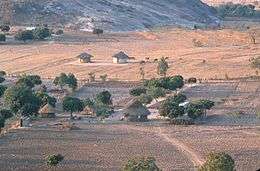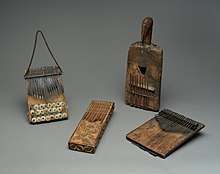Shona people
The Shona people (/ˈʃoʊnə/) are an ethnic group native to Southern Africa, primarily Zimbabwe (where they form the vast majority). They have five major clans, and are adjacent to other groups with similar cultures and languages.
| Total population | |
|---|---|
| 12 million (2000)[1] | |
| Regions with significant populations | |
| 11 million (2000)[1] | |
| 173,000[2][3] | |
| 30,200[4][5] | |
| Languages | |
| Shona | |
| Religion | |
| Christianity, traditional Shona religion | |
| Related ethnic groups | |
| Lemba, Kalanga, Venda and other Bantu peoples | |
Regional classification
The Shona people are divided into tribes in eastern and northern Zimbabwe. Their estimated population is 10.7 million:[6]
- Karanga or Southern Shona (about 4.5 million people)
- Zezuru or Central Shona (3.2 million people)
- Korekore or Northern Shona (1.7 million people)
Other members or close relatives:
- Manyika tribe or Eastern Shona (1.2 million)[7] in Zimbabwe (861,000) and Mozambique (173,000). Desmond Dale's basic Shona dictionary includes the Manyika dialect.[8]
- Ndau[9] in Mozambique (1,580,000) and Zimbabwe (800,000). Their dialect, partially mutually intelligible with the main Shona dialects, has click sounds which do not occur in standard Shona. Ndau has a wealth of Nguni words as a result of the Gaza Nguni occupation of their ancestral land in the 19th century.
Language and identity
When the term "Shona" was created during the early-19th-century Mfecane (possibly by the Ndebele king Mzilikazi), it was used as a pejorative for non-Nguni people; there was no awareness of a common identity by the tribes and peoples which make up the present-day Shona. The Shona people of the Zimbabwe highlands, however, retained a vivid memory of the ancient kingdom often identified with the Kingdom of Mutapa. The terms "Karanga", "Kalanga" and "Kalaka", now the names of discrete groups, seem to have been used for all Shona before the Mfecane.[10] Ethnologue notes that the language of the Bakalanga is mutually intelligible with the main dialects of Karanga and other Bantu languages in central and eastern Africa, but counts them separately. The Kalanga and Karanga are believed to be one clan who built the Mapungubwe, Great Zimbabwe and Khami, and were assimilated by the Zezuru. Although many Karanga and Kalanga words are interchangeable, Kalanga is different from Zezuru.
Dialect groups have many similarities. Although "standard" Shona is spoken throughout Zimbabwe, the dialects help identify a speaker's town (or village) and ethnic group. Each Shona dialect is specific to a certain ethnic group.
In 1931, during his attempt to reconcile the dialects into a single standard Shona language, Clement Doke[11] identified five groups and subdivisions:
- The Korekore (or Northern Shona), including Taυara, Shangwe, Korekore, Goυa, Budya, the Korekore of Urungwe, the Korekore of Sipolilo, Tande, Nyongwe of "Darwin", and Pfungwe of Mrewa
- The Zezuru group, including Shawasha, Haraυa, another Goυa, Nohwe, Hera, Njanja, Mbire, Nobvu, Vakwachikwakwa, Vakwazvimba, Tsunga
- The Karanga group, including Duma, Jena, Mari, Goυera, Nogoυa, and Nyubi
- The Manyika group, including Hungwe, Manyika themselves, Teυe, Unyama, Karombe, Nyamuka, Bunji, Domba, Nyatwe, Guta, Bvumba, Here, Jindwi, and Boca
- The Ndau group (mostly in Mozambique), including Ndau, Garwe, Danda, and Shanga
Dialects developed during the dispersion of tribes across Zimbabwe over a long period, and the influx of immigrants into the country from bordering countries has contributed to the variety.
History
During the 11th century, the Kalanga people formed kingdoms on the Zimbabwe plateau. Construction began on Great Zimbabwe, capital of the kingdom of Zimbabwe. The Torwa dynasty ruled the kingdom of Butua, and the kingdom of Mutapa preceded the Rozvi Empire (which lasted into the 19th century).
Brother succeeded brother in the dynasties, leading to civil wars which were exploited by the Portuguese during the 16th century. The kings ruled a number of chiefs, sub-chiefs and headmen.[12]
The kingdoms were replaced by new groups who moved onto the plateau. The Ndebele destroyed the Rozvi Empire during the 1830s; the Portuguese slowly eroded the kingdom of Mutapa, which extended to the Mozambique coast after it provided valued exports (particularly gold) for Swahili, Arab and East Asian traders. The British destroyed traditional power in 1890 and colonized the plateau of Rhodesia in 1890, and the Portuguese colonial government in Mozambique fought the remnants of the kingdom of Mutapa until 1902.[12]
Culture
Subsistence agriculture and mining

The Shona have traditionally practiced subsistence agriculture. They grew sorghum (largely replaced by maize), beans (since the middle of the first millennium AD), African groundnuts, and (beginning in the 16th century) pumpkins. Sorghum and maize are used to prepare the main dish, a thickened porridge called sadza, and the traditional beer known as hwahwa.[13] The Shona also keep cattle and goats, since livestock are an important food reserve during droughts.[12] Precolonial Shona states derived substantial revenue from the export of mining products, particularly gold and copper.[12]
Housing
Traditional Shona housing, known as musha, are round huts arranged around a cleared yard (ruvanze). Each hut has a specific function, such as a kitchen or a lounging space.[14]
Arts
Sculpture
The Shona are known for their stone sculptures, which were discovered during the 1940s. Shona sculpture developed during the eleventh century and peaked in the thirteenth and fourteenth centuries before beginning a slow decline until their mid-20th-century rediscovery. Although most of the sculptures are sedimentary-stone (such as soapstone) birds or humans, some are made with harder stone such as serpentinite and the rarer verdite. During the 1950s, Zimbabwean artists began carving stone sculptures for sale to European art lovers. The sculptures quickly became popular, and were bought and exhibited by art museums worldwide. Many of the sculptures depict the transformation of spirits into animals (or vice versa), and some are abstract. Many Zimbabwean artists carve wood and stone for sale to tourists, and traditional pottery also exists.
Clothing
Traditional textile production was high-quality, but expensive; the Shona preferred wearing skins or imported fabrics.[12]
Music

Shona traditional music, like other African traditional music, has constant melodies and variable rhythms. Its most important instruments are ngoma drums and the mbira. The drums vary in size and shape, depending on the type of music they are accompanying. The way in which they are played depends on the size of a drum and the type of music. Although large drums are typically played with sticks and smaller drums with an open palm, the small drum used for the amabhiza dance is played with a hand and a stick; the stick rubs, or scratches, the drum to produce a screeching sound.
The mbira has become a national instrument of sorts in Zimbabwe.[15] It has a number of variants, including the nhare, mbira dzavadzimu, the Mbira Nyunga Nyunga, njari mbira and matepe. The mbira is played at religious and secular gatherings, and the different mbiras have different purposes. The 22–24-key mbira dzavadzimu is used to summon spirits, and the 15-key Mbira Nyunga Nyunga is taught from primary school to university. Shona music also uses percussion instruments such as the marimba (similar to a xylophone), hosho (shakers), leg rattles, wooden clappers (makwa) and the chikorodzi, a notched stick played with another stick.
Religion

Although sixty to eighty percent of the Shona people are Christians, traditional beliefs remain. According to Shona tradition, the afterlife is not another world (like the Christian heaven and hell) but another form of existence in this world. The Shona attitude towards dead ancestors is very similar to their attitude towards living parents and grandparents.[16] The Bira ceremony, which often lasts all night, summons ancestral spirits for guidance and help.
In Zimbabwe, totems (mutupo) have been used by the Shona people since their culture developed. Totems identify clans, and up to 25 totems have been identified. Similar totems exist among the South African Tswana, Zulu, Northern Ndebele and Herero.[17] The totem system is problematic for orphans (especially abandoned babies), who may not have a totem.[18][19]
Notable Shona People
- Nehanda Charwe Nyakasikana
- Nelson Chamisa
- Dereck Chisora
- Herbert Chitepo
- Constantino Chiwenga
- Stella Chiweshe
- Phillip Chiyangwa
- Chartwell Dutiro
- Danai Gurira
- Tonderai Kasu
- Thomas Mapfumo
- Strive Masiyiwa
- Paul Tangi Mhova Mkondo
- Emmerson Mnangagwa
- Oliver Mtukudzi
- Grace Mugabe
- Robert Mugabe
- Joice Mujuru
- Solomon Mujuru
- Solomon Mutswairo
- Jah Prayzah
- Shingai Shoniwa
- Rekayi Tangwena
- George Tawengwa
- Tererai Trent
- Morgan Tsvangirai
- Winky D
See also
.svg.png)
Citations
- Ehnologue: Languages of Zimbabwe Archived 2016-03-04 at the Wayback Machine, citing Chebanne, Andy and Nthapelelang, Moemedi. 2000. The socio-linguistic survey of the Eastern Khoe in the Boteti and Makgadikgadi Pans areas of Botswana.
- "Ethnologue: Languages of Mozambique". Archived from the original on 2015-02-21. Retrieved 2015-06-04.
- "Ethnologue: Languages of Botswana". Archived from the original on 2013-09-29. Retrieved 2015-05-28.
- "Ethnologue: Languages of Zambia". Archived from the original on 2016-03-05. Retrieved 2015-05-28.
- Joshua project: South Africa
- "Shona". Ehnologue. (subscription required)
- Ethnologue: Manyika
- D. Dale:
- Basic English – Shona dictionary, Afro Asiatic Languages Edition, Sept 5, 2000, ISBN 978-0869220146
- Duramazwi: A Shona - English Dictionary, Afro Asiatic Languages Edition, Sept 5, 2000, ISBN 978-0869220146
- Ethnologue: Ndau
- Zimbabwes rich totem strong families – a euphemistic view on the totem system Archived 2015-05-28 at the Wayback Machine
- Doke, Clement M.,A Comparative Study in Shona Phonetics. 1931. University of Witwatersrand Press, Johannesburg.
- David N. Beach: The Shona and Zimbabwe 900–1850. Heinemann, London 1980 und Mambo Press, Gwelo 1980, ISBN 0-435-94505-X.
- Correct spelling according to D. Dale, A basic English Shona Dictionary, mambo Press, Gwelo (Gweru) 1981; some sources write "whawha", misled by conventions of English words like "what".
- Friedrich Du Toit, Musha: the Shona concept of home, Zimbabwe Pub. House, 1982
- "Music in Zimbabwe". Nordiska Afrikainstitutet. 16 March 2006. Archived from the original on 26 December 2007. Retrieved 23 May 2020.
... only in Zimbabwe has [the mbira] risen to become something of a national instrument.
- Michael Gelfand, The spiritual beliefs of the Shona, Mambo Press 1982, ISBN 0-86922-077-2, with a preface by Father M. Hannan.
- Totem Author: Magelah Peter - Published: May 21, 2007, 4:56 am
- "Baby dumping in Zimbabwe". Archived from the original on 2015-05-28. Retrieved 2015-05-28.
- Orphan for Life
Further reading
- "Arts and Culture in the 'Royal Residence'" (PDF). Journal of Pan African Studies, vol. 12, no. 3, Oct. 2018, pp. 141–149. EBSCOhost 133158724.(registration required)
- McEwen, Frank. "Shona Art Today". African Arts, vol. 5, no. 4, 1972, pp. 8–11. JSTOR 3334584.
- Van Wyk, Gary; Johnson, Robert (1997). Shona. New York: Rosen Pub Group. ISBN 9780823920112.
- Zilberg, Jonathan L. Zimbabwean Stone Sculpture: The Invention of a Shona Tradition, University of Illinois at Urbana-Champaign, Ann Arbor, 1996. ProQuest 304300839.